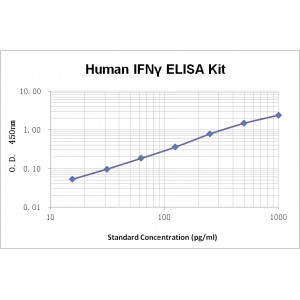Data sheet
| Storage |
More info
Assay Range | 15.6--1000 pg/mL |
Sensitivity | 2.0 pg/mL |
Specificity | No cross-reaction with other related substances detected |
Size | 96T |
Storage | Store at 2 - 8ºC. Keep reconstituted standard and detection Ab at -20 ºC |
Assay Principle | Sandwich ELISA |
Sample Volume | 100 µL final volume, dilution factor varies on samples |
Sample Type | serum, plasma or cell culture supernatant |
Detection Method | Chromogenic |
Kit Components
1. Recombinant Human IFN gamma standard: 2 vials
2. One 96-well plate coated with Human IFN gamma Ab
3. Sample diluent buffer: 12 mL - 1
4. Detection antibody: 130 µL, dilution 1:100
5. Streptavidin-HRP: 130 µL, dilution 1:100
6. Antibody diluent buffer: 12 mL x1
7. Streptavidin-HRP diluent buffer: 12 mL x1
8. TMB developing agent: 10 mL x1
9. Stop solution: 10 mL x1
10. Washing solution (20x): 25 mL x1
Background
Interferon gamma (IFN-γ), also known as type II interferon, is a member of the cytokine family and the only member of the type II class of interferons identified so far. IFN-γ is produced by a number of cell types under inflammatory conditions, including dendritic epidermal/γδT cells, keratinocytes, peripheral blood γδT cells, mast cells, neurons, CD8+ T cells, macrophages, B cells, neutrophils, NK cells, CD4+ T cells, and testicular spermatids. Biologically active IFN-γ consists of a noncovalently linked homodimer which binds to transmembrane IFN-γ RI (alpha subunit) coupled with transmembrane IFN-γ RII (beta subunit) to form a functional receptor complex of two α and two β subunits. IFNγ is essential to promote anti-viral, anti-proliferative, and immunoregulatory activities. On many cell types, IFN-γ induces the production of cytokines and upregulates the expression of various membrane proteins including class I and II MHC antigens, Fc receptors, leukocyte adhesion molecules, and B7 family antigens. IFN-γ also plays a key role in the pathogenesis of certain inflammatory diseases such as autoimmunity and atherosclerosis.


